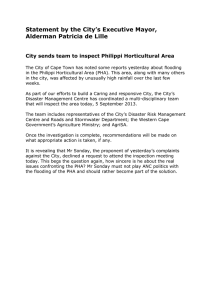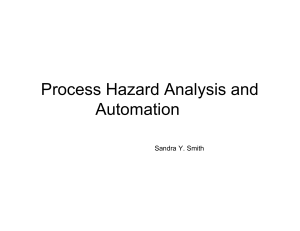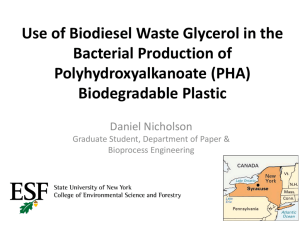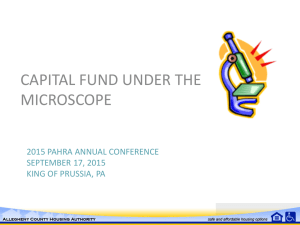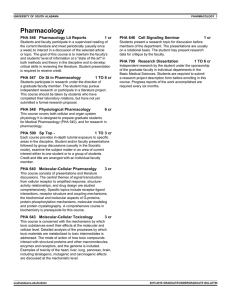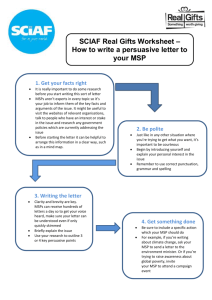Meaningful Use Stage 2 Public Health Agency Readiness
advertisement
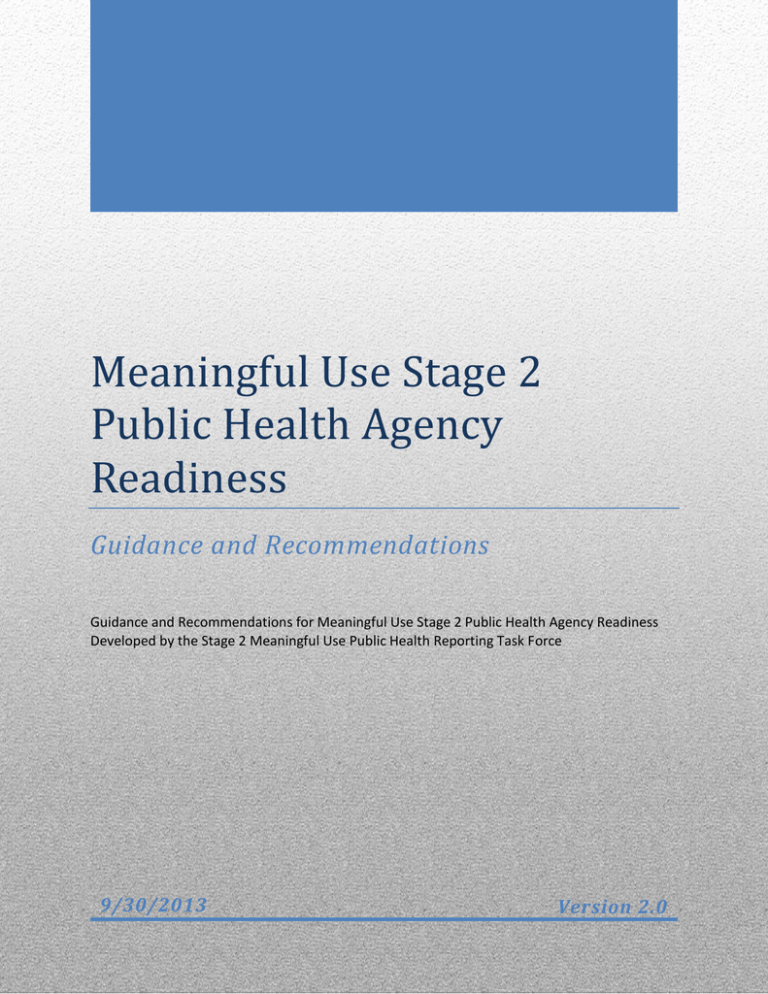
Meaningful Use Stage 2 Public Health Agency Readiness Guidance and Recommendations Guidance and Recommendations for Meaningful Use Stage 2 Public Health Agency Readiness Developed by the Stage 2 Meaningful Use Public Health Reporting Task Force 9/30/2013 Version 2.0 Meaningful Use Stage 2 Public Health Agency Readiness Guidance and Recommendations Revision History Date 04/09/2013 09/30/2013 Version 1.0 2.0 Description Initial version – published 04/09/2013 Acknowledgements Page – Changed to alphabetic listing by last name Grammatical edits throughout document Updates and clarifications throughout document Section 2 - Updated to reflect current status of CMS repository Section 5 - Changed the process name from “Acknowledgements” to “Acknowledgement of Ongoing Submission” and updated other sections to reflect this process scope clarification Section 6 - modified and added references Stage 2 Meaningful Use Public Health Reporting Task Force 09/30/2013 Version 2.0 1 Meaningful Use Stage 2 Public Health Agency Readiness Guidance and Recommendations Acknowledgements This document was developed by the Stage 2 Meaningful Use Public Health Reporting Task Force (Task Force), a collaboration between the Centers for Disease Control and Prevention (CDC), national non-profit public health associations, and public health practitioners from around the country. We would like to acknowledge the contributions and support provided by the public health associations, public health agencies, and federal agencies involved in the Task Force. Specifically, we would like to thank the following individuals for their active participation in the development of this document: Sundus Adhi, Deloitte Consulting LLP (CDC Contractor) Noam Arzt, HLN Consulting, LLC Wendy Blumenthal, Centers for Disease Control and Prevention (CDC) Bill Brand, Public Health Informatics Institute (PHII) Frank Caniglia, Pennsylvania Department of Health Daniel Chaput, Rhode Island Department of Health Alison Chi, American Immunization Registry Association (AIRA) Michael Coletta, National Association of County and City Health Officials (NACCHO) Laura Conn, Centers for Disease Control and Prevention (CDC) Glenn Copeland, Michigan Department of Community Health Rebecca Coyle, American Immunization Registry Association (AIRA) Jim Daniel, Office of the National Coordinator for Health Information Technology (ONC) Hunter Davis, Florida Department of Health Brook Dupee, New Hampshire Department of Health and Human Services Emily Emerson, Minnesota Department of Health Cathy Fiato, New York State Department of Health Seth Foldy, Principal, SethFoldy.com Consultant in preventive health systems and informatics Nedra Garrett, Centers for Disease Control and Prevention (CDC) Sarah Goff, New York State Department of Health Scott Gordon, Association of State and Territorial Health Officials (ASTHO) Janet Hamilton, Council of State and Territorial Epidemiologists (CSTE) Gillian Haney, Massachusetts Department of Public Health Lori Havener, North American Association of Central Cancer Registries (NAACCR) Gary Heckert, Delaware Health and Social Services Michelle Hood, Nebraska Department of Health and Human Services Leah Huang, Arkansas Department of Health Monica Huang, Council of State and Territorial Epidemiologists (CSTE) Charlie Ishikawa, International Society for Disease Surveillance (ISDS) Jim Jellison, Public Health Informatics Institute (PHII) Mark Jensen, Business Computer Applications, Inc. (CDC Contractor) Geraldine Johnson, New York State Department of Health Sandy Jones, Centers for Disease Control and Prevention (CDC) Bryant Karras, State of Washington, Department of Health Janet Kelly, Centers for Disease Control and Prevention (CDC) James Kirkwood, New York State Department of Health Micheal Knox, Arkansas Department of Health Emilie Lamb, North Carolina Division of Public Health Mike McPherson, Kansas Department of Health and Environment Laura Rappleye, Altarum Institute Brandon Rosner, Wisconsin Department of Health Services Anita Samuel, Association of State and Territorial Health Officials (ASTHO) Jonathan Schultz, Arkansas Department of Health Carmen Springer, Alaska Department of Health and Social Services, Division of Public Health David Stinchcomb, North American Association of Central Cancer Registries (NAACCR) Sanjeev Tandon, Centers for Disease Control and Prevention (CDC) Denise Webb, Wisconsin Department of Health Services Melanie Williams, Texas Department of State Health Services Wake Young, Arkansas Department of Health The Task Force welcomes comments on this document. Please send all comments to meaningfuluse@cdc.gov. This document represents our best efforts to reflect the evolving understanding of how Stage 2 Meaningful Use regulations will be implemented for public health. The Task Force reserves the right to modify this document. Stage 2 Meaningful Use Public Health Reporting Task Force 09/30/2013 Version 2.0 2 Meaningful Use Stage 2 Public Health Agency Readiness Guidance and Recommendations Table of Contents 1 Overview....................................................................................................................................4 1.1 Background ................................................................................................................................... 4 1.2 What kind of guidance is available to the Public Health Agencies (PHAs)?.................................. 5 2 Declaration of Readiness ............................................................................................................6 2.1 What does Declaration of Readiness mean? ................................................................................ 6 2.2 What do the regulations say? ....................................................................................................... 6 2.3 What does this mean for a Public Health Agency? ....................................................................... 7 2.4 What actions can a Public Health Agency take now? ................................................................... 8 3 Registration of Intent..................................................................................................................9 3.1 What does Registration of Intent mean?...................................................................................... 9 3.2 What do the regulations say? ....................................................................................................... 9 3.3 What does this mean for a Public Health Agency? ..................................................................... 10 3.4 What actions can a Public Health Agency take now? ................................................................. 10 4 On-Boarding ............................................................................................................................. 12 4.1 What is On-Boarding? ................................................................................................................. 12 4.2 What do the regulations say? ..................................................................................................... 12 4.3 What does this mean for Public Health Agencies? ..................................................................... 13 4.4 What actions can a Public Health Agency take now? ................................................................. 15 5 Acknowledgement of Ongoing Submission ................................................................................ 16 5.1 What are Acknowledgements of Ongoing Submission? ............................................................. 16 5.2 What do the regulations say? ..................................................................................................... 16 5.3 What does this mean for a Public Health Agency? ..................................................................... 16 5.4 What actions can a Public Health Agency take now? ................................................................. 17 6 Other Resources ....................................................................................................................... 18 6.1 Where to go for resources and additional information? ............................................................ 18 Stage 2 Meaningful Use Public Health Reporting Task Force 09/30/2013 Version 2.0 3 Meaningful Use Stage 2 Public Health Agency Readiness Guidance and Recommendations 1 Overview 1.1 Background The Stage 2 Meaningful Use (MU2) Final Rules1 published in the Federal Register on September 4, 2012, strongly encourage local and state Public Health Agencies (PHAs) and central cancer registries2 to ramp-up their informatics capabilities and establish new processes to receive MU public health data from Eligible Professionals (EPs) and Eligible Hospitals (EHs). In MU2, ongoing submission of electronic data for immunizations is in the core set of objectives for EPs and ongoing submission of electronic data for immunizations, reportable laboratory results, and syndromic surveillance are in the core set for EHs. In addition, EPs have menu set objectives for reporting syndromic surveillance data, for reporting to cancer registries, and other specialized registries (e.g., birth defects registries, chronic disease registries, traumatic injury registries, prescription drug monitoring). PHAs are strongly encouraged, though not required, to support MU2 public health objectives. These objectives represent tremendous opportunities for PHAs to improve their data acquisition and surveillance capabilities. Providers3 whose public health jurisdictions lack the capacity to support MU2 objectives will be exempted from meeting those objectives. MU2 regulations for the public health objectives suggest that PHAs also need to perform four (4) new administrative tasks to fully support MU2 (Figure 1). The processes that PHAs will need to develop are: Publicize what MU2 objectives the PHA will support and share this information with the proposed Centers for Medicare & Medicaid (CMS) centralized PHA capacity repository (Declaration of Readiness process), Register Providers who plan to submit public health data to a PHA for MU2 objectives (Registration of Intent process), Test and validate ongoing data submissions from Providers (On-Boarding process), Provide written communication(s) (which may be in electronic format) to Providers who have achieved ongoing submission of data relevant to public health for MU2 objectives. (Acknowledgement of Ongoing Submission process). 1 Centers for Medicare & Medicaid Services (CMS), Stage 2 Meaningful Use Final Rule, (Available at: http://www.gpo.gov/fdsys/pkg/FR-2012-09-04/pdf/2012-21050.pdf); Office of the National Coordinator for Health Information Technology (ONC), 2014 Standards and Certification Final Rule, (Available at: http://www.gpo.gov/fdsys/pkg/FR-2012-09-04/pdf/2012-20982.pdf) 2 Some central cancer registries (CCR) operate outside of the PHA environment (e.g., CCR is in a university). 3 Includes eligible professionals, hospitals, and critical access hospitals that intend to meet (MU2) public health objectives. Stage 2 Meaningful Use Public Health Reporting Task Force 09/30/2013 Version 2.0 4 Meaningful Use Stage 2 Public Health Agency Readiness Guidance and Recommendations Figure 1: The four new administrative tasks for PHAs to support MU2. The Centers for Disease Control & Prevention (CDC) has facilitated the establishment of the Stage 2 MU Public Health Reporting Requirements Task Force (Task Force) with representatives from the public health community, including: National Association of County and City Health Officials (NACCHO), Association of State and Territorial Health Officials (ASTHO), Joint Public Health Informatics Taskforce (JPHIT), International Society for Disease Surveillance (ISDS), Council of State and Territorial Epidemiologists (CSTE), Public Health Informatics Institute (PHII), North American Association of Central Cancer Registries (NAACCR), American Immunization Registry Association (AIRA), Office of the National Coordinator for Health Information Technology (ONC), CDC, State PHAs, and others. 1.2 What guidance is available to help Public Health Agencies (PHAs)? The Task Force has framed documentation that will identify key concepts, task flows and guidance for PHAs to support MU public health objectives and associated new business processes required for MU2. The Task Force has developed: Recommendations to CMS for their proposed centralized PHA capacity repository which will supply Providers with information on their PHA’s capacity to accept electronic data for MU2 public health objectives. Guidance for PHAs to declare readiness to receive data for MU2, and to facilitate the registration of intent by Providers, on-boarding and ongoing submission, and the ability to provide acknowledgements to Providers. Guidance related to transport protocols for the electronic submission of data to PHAs for the MU public health objectives. Guidance on how PHAs can leverage the specialized registry MU2 objective to obtain case information on public health reporting information such as birth defects, traumatic injuries, hearing and vision and other public health surveillance information. PHAs across the nation will be able to adopt this guidance according to their jurisdictional needs to implement the new objectives and processes required for MU2. This guidance is available on the Task Force’s community site on phConnect (http://www.phconnect.org/group/ph-reporting-taskforce). Stage 2 Meaningful Use Public Health Reporting Task Force 09/30/2013 Version 2.0 5 Meaningful Use Stage 2 Public Health Agency Readiness Guidance and Recommendations 2 Declaration of Readiness 2.1 What does Declaration of Readiness mean? For MU2, any PHA that intends to receive electronic data from Providers will need to declare its readiness for receiving such data; otherwise Providers may claim exclusions from MU2 public health objectives. CMS is developing a centralized repository of information from PHAs describing their readiness for the various public health reporting objectives contained in the MU2 regulations. Having this information in a centralized repository will enable "one-stop shopping" for Providers and vendors seeking information on specific public health jurisdictional readiness to accept reporting for the MU2 objectives. PHAs will need to publicly declare their MU2 readiness in some fashion (e.g., on the PHA’s website) even if CMS does not provide a national repository or until such time as CMS establishes this repository. Important Status Update: Recently, CMS has indicated the centralized repository will not be available in a definitive form when MU2 starts on October 1, 2013 for eligible hospitals. Therefore, eligible hospitals will have to work directly with their Reference CMS Stage 2 Final Rule: PHAs and registries, as is currently the case under (77 FR 54021| http://www.federalregister.gov/a/2012MU1, until CMS makes the centralized repository 21050/p-1007) available. CMS is expecting that the centralized “Comment: Commenters asked for clarification of ongoing submission; additionally, due to the amount repository will be available for Providers prior to of time needed to prepare for submission of data, January 1, 2014. commenters asked for clarification on the timing to 2.2 What do the regulations say? The regulations say that a Provider must determine which MU2 public health objectives are supported by the PHA to which it reports. Furthermore, the Provider must make this determination within the first 60 days of the Electronic Health Records (EHR) reporting period4. The EHR reporting period is the time period through which a Provider seeking MU incentive payments must demonstrate meaningful use of EHR technology. The regulations indicate that CMS anticipates, but does not commit to, building a centralized repository of PHA readiness information. Regardless, PHAs must officially declare for which of the public health objectives it has the capacity to receive information using the standards and specifications prescribed by the Office of the National Coordinator for Health IT (ONC) Final Rule. For MU2, Providers must provide ongoing submission of actual patient data. The five public health objectives are: determine if a public health authority has the capacity to accept electronic data for ongoing submission. Other commenters noted that being "in queue" or in the process of validation for ongoing submission should count as meeting this measure. Commenters also noted that credit should be given for having moved into ongoing submission during Stage 1. Response: To clarify the timing issue, the EP or hospital must determine if the PHA has the capacity to accept electronic data using the specification prescribed by ONC for the public health information for the objectives of Meaningful Use within the first 60 days of the EHR reporting period. If the PHA does not have the capacity to accept reporting (including situations when the PHA accepts electronic data but states it lacks capacity to enroll the EP, eligible hospital or CAH during that reporting period), the EP or hospital can claim an exclusion for this measure related to the data that cannot be accepted. In determining whether the PHA has the capacity, CMS anticipates developing a centralized repository for this information, including a deadline for the PHA to submit information. If the PHA fails to provide information to this centralized repository by the deadline, the Provider could claim the exclusion. In the event, that we are unable to develop a centralized repository, Providers will make the determination of PHA capacity by working directly with the PHA as is currently the case for Stage 1 of Meaningful Use.” Capability to submit electronic data to immunization registries or immunization information systems except where prohibited, and in accordance with applicable law and practice. 4 For 2014 only, all providers are only required to demonstrate meaningful use for a three-month EHR reporting period selected by the provider. Stage 2 Meaningful Use Public Health Reporting Task Force 09/30/2013 Version 2.0 6 Meaningful Use Stage 2 Public Health Agency Readiness Guidance and Recommendations Capability to submit electronic reportable laboratory results to public health agencies, where except where prohibited, and in accordance with applicable law and practice. Capability to submit electronic syndromic surveillance data to public health agencies, except where prohibited, and in accordance with applicable law and practice. Capability to identify and report cancer cases to a public health central cancer registry, except where prohibited, and in accordance with applicable law and practice. Capability to identify and report specific cases to a specialized registry (other than a cancer registry), except where prohibited, and in accordance with applicable law and practice. Very importantly, the regulations say that if the PHA fails to provide readiness information for any or all of the MU2 measures to this centralized repository by the deadline (to be established by CMS), the provider could claim the exclusion. Lastly, the regulations say that if CMS does not establish the centralized repository, Providers must determine PHA capacity by working directly with the PHAs to which they report, as they did in Stage 1 of Meaningful Use (MU1). 2.3 What does this mean for a Public Health Agency? A PHA will need to declare which MU2 public health objectives it will support and which ONCapproved standards it will require Providers to use. CMS will set a deadline for PHAs to submit their readiness information. If CMS does not build a centralized repository or until such time the centralized repository is available, Providers will make the determination of PHA capacity by working directly with the PHA as is currently the case for MU1. It is important to note that the term capacity as used in the regulations refers to two aspects of readiness: (1) the PHA has the technical capacity to receive data using the specified standards; and (2) the PHA has the administrative capacity to enroll the Provider during the reporting period. Receiving data could mean directly, through a certified HIE, or via a national system such as BioSense 2.0. PHAs with the technical capacity to Figure 2: Graphical representation of the how the declaration of readiness receive data are encouraged to declare process will work. their readiness to receive data even if they have limited administrative capacity. PHAs may be able to use queuing to prioritize providers for on-boarding and manual processes for tracking and on-boarding to effectively manage the administrative workload. For more information on administrative PHA capacity, please refer to the sections on Registration of Intent, On-Boarding, and Acknowledgement of Ongoing Submission. It is not yet known how frequently CMS will allow a PHA to update its readiness information. The Stage 2 Meaningful Use Public Health Reporting Task Force 09/30/2013 Version 2.0 7 Meaningful Use Stage 2 Public Health Agency Readiness Guidance and Recommendations Task Force has recommended to CMS that it allow agencies to periodically update their status. Reporting periods are 3 months in length in 2014, so a declaration might be made for each period, then annually thereafter. CMS will provide some form or template to PHAs identifying the information required for the centralized repository and the Task Force has provided CMS with a list of recommended data elements for this purpose. These include supported public health objectives for both MU2 and MU1 and the transport and messaging standards used to meet these objectives. The regulations allow PHAs to determine what transport mechanisms they will support in their jurisdictions, although choosing a transport method(s) already used by healthcare and certified EHR systems is a prudent long-term strategy. Lastly, if CMS does not create this centralized repository, a PHA will need its own communication strategy for letting Providers know what the PHA will be ready for, such as providing information on the PHA website. Key Process Communications: PHA submitting readiness information and updates to CMS for the centralized repository. 2.4 What actions can a Public Health Agency take now? In some states, both state and local PHAs are accepting MU data submissions from Providers. If the PHA has not already done so, consider convening a cross-agency/cross-program task force to coordinate the planning, implementation, and communications for MU2. State and local agency needs, as well as coordinated efforts with Medicaid and state and local HIE and HIT bodies, should be considered to ensure that stakeholders are familiar with expectations for PHAs. The information in this document and the other resources listed in the Resources section can help PHAs prepare. Also, consider developing a Meaningful Use home page on the agency's website where Providers can access general information about agency readiness and be directed to more specific information on whichever of the reporting objectives for which it will be ready. The Meaningful Use information on the agency’s website should be consistent with the declaration of readiness information the agency provides to CMS for the centralized repository. Stage 2 Meaningful Use Public Health Reporting Task Force 09/30/2013 Version 2.0 8 Meaningful Use Stage 2 Public Health Agency Readiness Guidance and Recommendations 3 Registration of Intent 3.1 What does Registration of Intent mean? Providers that intend to meet MU2 public health objectives must register their intent to do so with the PHA to which the Provider intends to submit data. Providers must register their intent with the PHA no later than the 60th day of the start of their EHR reporting period. The EHR reporting period is the time period through which a Provider seeking MU incentive payments must demonstrate meaningful use of EHR technology. The EHR reporting period is selected by the Provider. The earliest that Providers can demonstrate MU2 is 2014 (calendar year 2014 for eligible professionals and fiscal year 2014 for eligible hospitals and critical access hospitals). For 2014, the Medicare EHR reporting period is a 3-month period that is fixed to the quarters of either calendar or fiscal 2014. Medicaid EPs will attest using an EHR reporting period of any continuous 90-day period during calendar 2014 or, if the state Medicaid program so chooses, any 3-month calendar quarter in 2014. Therefore, for MU2, the earliest EHR reporting period start dates are October 1, 2013 (for eligible hospitals and critical access hospitals) and January 1, 2014 (for eligible professionals). 3.2 What do the regulations say? MU2 public health objectives require ongoing submission of actual patient data and, as described above, Providers will be contacting PHAs to register their intent to do so. If the PHA has the capacity to accept Providers’ data (see Declaration of Readiness section for additional details), a Provider can meet a MU2 public health objective through any of the following four (4) criteria5: Ongoing submission was already achieved for an EHR reporting period in a prior year and continues throughout the current EHR reporting period using either the current (2014 Edition) standards or the standards included in the 2011 Edition EHR certification criteria6 adopted by ONC during the prior EHR reporting period when ongoing submission was achieved. Registration with the PHA or other body to whom the information is being submitted of intent to initiate ongoing submission was made by the deadline (within 60 days of the start of the EHR reporting period) and ongoing submission was achieved. Registration of intent to initiate ongoing submission was made by the deadline and the EP or hospital is still engaged in testing and validation of ongoing electronic submission (see On-Boarding section for additional details). Registration of intent to initiate ongoing submission was made by the deadline and the EP or hospital is awaiting invitation to begin testing and validation (see On-Boarding section for additional details). The measure will not be met if the Provider Fails to register their intent by the deadline; or Fails to participate in the on-boarding process as demonstrated by failure to respond to the PHA written requests for action within 30 days on two separate occasions (see On-Boarding section for additional details). 5 From the CMS Stage 2 Final Rule 77 FR 54021 - http://www.federalregister.gov/a/2012-21050/p-1009 Grandfathering providers - PHAs and immunization information system will decide whether to continue accepting immunization and syndromic surveillance data sent using the HL7 2.3.1 standard from providers that achieved ongoing submission prior to the start of MU2 (Refer to: http://www.gpo.gov/fdsys/pkg/FR-2012-09-04/pdf/2012-21050.pdf, Pages 54023, 54025, 54026) 6 Stage 2 Meaningful Use Public Health Reporting Task Force 09/30/2013 Version 2.0 9 Meaningful Use Stage 2 Public Health Agency Readiness Guidance and Recommendations 3.3 What does this mean for a Public Health Agency? In MU2 the PHAs are tasked with declaring their readiness to accept data from Providers, registering Providers that intend to submit data, establish a testing and validation process to onboard Providers, and acknowledging those Providers that successfully submit data. It is not the role of the PHA to determine if Providers meet MU objectives or qualify for incentive payments. Outcomes from Providers registering their intent to meet MU public health objectives should include: PHAs having information on Providers that plan to submit data to the PHA for MU2 (although not mandated, this could also include MU1) Providers having the information they need to begin on-boarding To successfully achieve these outcomes, PHAs should develop processes and tools to facilitate registering, on-boarding, and acknowledging Providers. A critical success factor will be tracking and documenting communications between a PHA and Providers reporting within their jurisdiction. The PHA registration process should provide some type of confirmation (e.g., email, webpage Figure 3: Graphical representation of how the registration of intent process confirmation, letter) when the should work. Provider successfully registers. The Providers will need this documentation to support their attestation for MU2. Key Process Communications: Providers that intend initiate ongoing submission for MU2 objectives registering their intent to do so with the PHA. The PHA registration process providing some confirmation when the Provider successfully registers their intent. 3.4 What actions can a Public Health Agency take now? At a minimum, PHAs should establish a process to register Providers as they contact PHAs to indicate their intent to submit data to meet MU2 public health objectives. Some PHAs may implement a simple registration process, while others may use more elaborate electronic registration and tracking processes. This registration process should entail capturing information on the Provider that will later facilitate on-boarding. This information could vary depending on the type of Provider (e.g., hospitals, group practices, integrated healthcare delivery networks). It’s possible the registration process will need to accommodate Providers at various stages of Meaningful Use. A detailed list of recommended data elements to capture during Provider Stage 2 Meaningful Use Public Health Reporting Task Force 09/30/2013 Version 2.0 10 Meaningful Use Stage 2 Public Health Agency Readiness Guidance and Recommendations registration can be found in a functional requirements document developed by the Task Force7. This functional requirements document is intended for a technical audience that might be tasked with developing tools or a system to support the Provider registration processes. As Providers register, PHAs should consider providing them implementation guides and other guidance to prepare them for on-boarding (see the sections on On-Boarding and Acknowledgement of Ongoing Submission for additional details). The PHA could include an invitation to begin onboarding or information that helps the Provider know when to expect this invitation. PHA should consider establishing an MU Coordinator (see CDC Director's Guidance on MU Coordinator Role) or other dedicated resource(s) to lead and coordinate the PHA’s response to the Meaningful Use requirements. It’s also recommended that the PHA work with a designated point of contact representing the Provider, which could be an individual professional, hospital, group practice, or integrated delivery network. PHAs should leverage the Regional Extension Centers (RECs) serving providers in their jurisdiction. For example, RECs can help providers understand the requirement to register their intent with the PHA and successfully complete the registration process. If the PHA has not already done so, consider convening a cross-agency/cross-program task force to coordinate the planning, implementation, and communications for MU2 (see Section 2.4 for additional details). 7 This document is available on the Task Force’s community site on phConnect (http://www.phconnect.org/group/ph-reporting-task-force). Stage 2 Meaningful Use Public Health Reporting Task Force 09/30/2013 Version 2.0 11 Meaningful Use Stage 2 Public Health Agency Readiness Guidance and Recommendations 4 On-Boarding 4.1 What is On-Boarding? On-boarding refers to the testing and validation process that health care providers and PHAs collaboratively engage in to integrate clinical electronic data feeds into public health surveillance systems and immunization registries. Providers seeking to meet MU2 public health objectives will be required to provide actual patient data from production systems (i.e., not systems used for testing). Providers participate in a PHA’s on-boarding process by first registering with a PHA (see Registration of Intent section for additional details) and then responding to a PHA’s written request for action. These actions can include sending data for a PHA’s testing and correcting data that fails a PHA’s validation. Since there are multiple MU2 public health objectives, Providers may be concurrently engaged with a PHA in multiple on-boarding processes. An on-boarding process ends when the Provider is routinely submitting actual patient data that passes PHA’s validation. 4.2 What do the regulations say? For MU2, the capability to submit electronic immunization data, reportable lab results, and syndromic surveillance data are core, or mandatory, objectives for eligible hospitals and critical access hospitals. For eligible professionals, submission of immunization data is a core objective. Eligible professionals may also seek to meet menu objectives for submission of syndromic surveillance data, cancer registry data, or other specialized registry data. The MU2 regulations indicate Providers can meet public health objectives by first registering with the PHAs to which they will be submitting data and then either: achieving ongoing submission of data, or being engaged with the PHA in testing and validation of data, or waiting for an invitation from the PHA to begin testing and validation. Providers that fail to respond within 30 calendar days to PHA requests for action on two (2) separate occasions will not meet the public health measure for which action was requested8. As noted above, successful ongoing submission is one way a Provider can meet a MU2 public health objective by satisfying the corresponding measure. The MU2 regulations provide the following description of ongoing submission: … we describe successful ongoing submission as electronic submission of reportable data during the normal course of a provider's operations. This is not to say all data that is reportable is sent to the PHA. A provider who is submitting any reportable data during their normal course of their operations is engaged in ongoing submission. A provider that can only submit reportable data in a test environment or other circumstance that is not part of their normal operations would not be engaged in ongoing submission.9 The MU2 regulations go on to discuss the requirement to submit information to a PHA in accordance with applicable law and practice: … we believe that the requirement to submit information would be under applicable law, the agreements between the provider and PHA, or through Meaningful Use which requires submissions 8 9 From the CMS Stage 2 Final Rule 77 FR 54021 - http://www.federalregister.gov/a/2012-21050/p-1009 From the CMS Stage 2 Final Rule 77 FR 54022 - http://www.federalregister.gov/a/2012-21050/p-1021 Stage 2 Meaningful Use Public Health Reporting Task Force 09/30/2013 Version 2.0 12 Meaningful Use Stage 2 Public Health Agency Readiness Guidance and Recommendations except where prohibited, so it is not necessary for Meaningful Use to monitor the already mandated submission10. All the MU2 public health objectives include the phrases “except where prohibited” and “in accordance with applicable law and practice.” The phrase “except where prohibited” is meant to encourage reporting to a PHA by a Provider even when there is no explicit reporting requirement. For example, voluntary participation in a registry does not require authorization to do so. The phrase “in accordance with applicable law and practice” allows PHAs to use their existing laws, regulations, and business practices in structuring the data reported from Providers to the PHA. In addition, this phrase also ensures MU2 does not preempt applicable state or local laws that govern reporting to the PHA11. A PHA may designate or authorize a third party, such as a Health Information Exchange (HIE), to serve as an ongoing destination or conduit for the Provider’s MU data. If, however, this intermediary transforms the Provider’s data or message format to meet MU requirements, then the third party is not functioning merely as a conduit but rather as an extension of the Provider’s EHR. In such cases, the HIE must use certified EHR technology (CEHRT) to make the transformations, and Providers must attest to the PH measure using that certified module. Providers must ensure their submissions reach the PHA, except in cases where the PHA has explicitly stated submission to the HIE satisfies reporting requirements. 4.3 What does this mean for Public Health Agencies? PHAs will need to track the status of Providers throughout the on-boarding processes. This tracking process should begin when the Provider registers their intent to meet MU2 public health objectives. After registering, a Provider’s status could be described as a series of stages. As examples, these stages could include “waiting for on-boarding invitation,” “invited to on-board,” “currently onboarding,” or “in production.” A PHA’s tracking process should, at minimum, record when written requests to take action are sent to Providers and when a Provider responds to these written requests. These written requests should include invitations to begin on-boarding and requests for corrective actions the Provider may need to take during testing and validation. A Provider’s engagement in the testing and validation process can be demonstrated by the Provider’s responses to written requests for action from the PHA, or by any other evidence of compliance with the PHA’s request. Upon completion of the on-boarding process, the PHA will send communication(s) to the Provider confirming the Provider was able to submit the relevant public health data (see Acknowledgement of Ongoing Submission section for additional details). A provider that can only submit reportable data in a test environment that is not part of their normal operations would not be engaged in ongoing submission. Providers must still follow applicable state or local laws for reporting to a PHA. Although MU2 describes being engaged in ongoing submission as a Provider submitting any reportable data during their normal course of their operations, MU2 does not preempt applicable state or local laws that govern reporting to the PHA. In some jurisdictions, existing public health reporting rules may reflect more stringent requirements than the ongoing submission requirements outlined in the MU2 regulations. In those jurisdictions, ongoing submission with a PHA to satisfy a MU2 objective could enable a Provider to fulfill some of the reporting requirements to the PHA mandated by applicable state or local laws. 10 11 From the CMS Stage 2 Final Rule 77 FR 54022 - http://www.federalregister.gov/a/2012-21050/p-1021 From the CMS Stage 2 Final Rule 77 FR 54022 - http://www.federalregister.gov/a/2012-21050/p-1022 Stage 2 Meaningful Use Public Health Reporting Task Force 09/30/2013 Version 2.0 13 Meaningful Use Stage 2 Public Health Agency Readiness Guidance and Recommendations A PHA will likely be on-boarding Providers who intend to meet MU2 objectives and also those who intend to meet MU1 objectives. It is highly recommended that the PHA’s on-boarding process accommodates both MU1 and MU2. PHAs should consider establishing a MU Coordinator (see CDC Director's Guidance on MU Coordinator Role) or other dedicated resource(s) to lead and coordinate the PHA’s response to the Meaningful Use requirements. It is recommended that the PHAs work with a designated point of contact representing the Provider, or in the case of group practices and integrated delivery networks, collections of Providers. The Provider’s point(s) of contact would be the recipient of documentation that is needed for attestation with CMS. During the on-boarding process, Providers’ points of contact may work directly with PHA subject matter experts (SME) more familiar with the data and standards for a particular objective. PHAs are not responsible for verifying if Providers are using CEHRT or whether Providers are meeting CMS deadlines. Furthermore, PHAs are not expected to be the arbiters of Providers’ achievement of Meaningful Use or entitlement to incentive payments. Rather, PHAs are expected to document Provider’s activity as they register their intent to on-board, respond to the PHA’s requests during on-boarding, and achieve ongoing submission of data. The communications that a PHA sends to Providers will be evidence Providers use when they attest to CMS or are audited by CMS or the State Medicaid Program. Figure 4: Graphic representation of four ways that an EP or EH can meet the "on-going" submission measure for MU stage 2. Key Process Communications: PHA written requests to take action sent to the Provider that registered their intent to submit data for MU2 objectives. Examples of written requests include, but are not limited to: invitation to begin on-boarding, requests to complete on-boarding steps, and requests for corrective action during message testing and validation. Provider replies and responses to the PHA’s written requests to take action. Stage 2 Meaningful Use Public Health Reporting Task Force 09/30/2013 Version 2.0 14 Meaningful Use Stage 2 Public Health Agency Readiness Guidance and Recommendations 4.4 What actions can a Public Health Agency take now? PHAs should consider preparing on-boarding guidance for Providers when they register their intent to on-board. This guidance can include implementation guides, a PHA’s transport method requirements, and message validation resources. The goal of successful on-boarding is quality data that is useful for public health purposes, and it is critical Providers read and follow PHA’s implementation guides and other on-boarding guidance. PHA MU coordinators should consider holding internal meetings with PHA subject matter experts for immunization data, syndromic surveillance, electronic lab reports, cancer registries, and other specialized registries. During the on-boarding process, the MU coordinator could act as a liaison between the Provider and the PHA programs to which the Provider is attempting to submit data. The MU coordinator could track the communications between the Provider and PHA, while the PHA SMEs could provide detailed technical guidance during the testing and validation of data submissions. Stage 2 Meaningful Use Public Health Reporting Task Force 09/30/2013 Version 2.0 15 Meaningful Use Stage 2 Public Health Agency Readiness Guidance and Recommendations 5 Acknowledgement of Ongoing Submission 5.1 What are Acknowledgements of Ongoing Submission? Acknowledgements of ongoing submission are the official communications sent from PHAs to Providers that affirm a Provider has successfully submitted public health data for a MU2 public health objective. For MU2, Providers must provide ongoing submission of actual patient data. 5.2 What do the regulations say? MU2 regulations state that PHAs will provide written communications to affirm a Provider has submitted relevant public health data to the PHA12. In the event of an audit, Providers will use this written PHA communication to substantiate their attestation to CMS that they met MU2 public health measures. The regulations do not specify message text or a format for this written communication, but do indicate that electronic formats are permissible. 5.3 What does this mean for a Public Health Agency? The MU2 regulations allow PHAs to self-determine how they affirm a Provider has submitted the relevant public health data in a written communication (which may be in electronic format). This means that PHAs need to determine communication format and content as well as how to issue these written communications. Options PHAs should consider for the type of communication include, but are not limited to: emailing a message to the Provider mailing a letter to the Provider publishing the names of Providers on the PHA’s website using automated acknowledgements generated by systems that are receiving the Provider’s data (e.g., HL7 acknowledgement (ACK) messages from immunization submissions) Identifying and assessing the potential issues, challenges, and limitations associated with any option should be thoroughly considered by the PHA prior to making a decision. For the content, PHAs should acknowledge that a Provider submitted the relevant public health data to the PHA, but should not state that a Provider has achieved Meaningful Use or met the public health objective. Determinations regarding attestation will be made by CMS. As described in the Registration of Intent and On-Boarding sections, in order for PHAs to be effective in their role, PHAs should develop processes and tools to track the MU-related communications with Providers. These communications will include confirmation that Providers have registered their intent to submit data to the PHA, invitations to Providers to begin onboarding, requests for action Providers need to take during on-boarding, and acknowledgements that Providers have successfully submitted data. PHAs should inform the Providers to retain the PHA communications they receive in case they are audited by CMS or the State Medicaid Program. Key Process Communications: PHAs sending a Provider written communication (which may be in electronic format) to affirm the Provider has submitted the relevant public health data to the PHA. 12 From the CMS Stage 2 Final Rule 77 FR 54022 - http://www.federalregister.gov/a/2012-21050/p-1019 Stage 2 Meaningful Use Public Health Reporting Task Force 09/30/2013 Version 2.0 16 Meaningful Use Stage 2 Public Health Agency Readiness Guidance and Recommendations 5.4 What actions can a Public Health Agency take now? PHAs will need to determine the type, format, and content of the acknowledgements to provide for each of the MU2 public health objectives. In some states, both state and local PHAs are accepting MU data submissions from providers. If the PHA has not already done so, consider convening a cross-agency/cross-program task force to coordinate the planning, implementation, and communications for MU2. State and local agency needs, as well as coordinated efforts with Medicaid and state and local HIE and HIT bodies, should be considered to ensure that stakeholders are familiar with expectations for PHAs. This series of fact sheets and the other resources listed below can help PHAs prepare. Stage 2 Meaningful Use Public Health Reporting Task Force 09/30/2013 Version 2.0 17 Meaningful Use Stage 2 Public Health Agency Readiness Guidance and Recommendations 6 Other Resources 6.1 Where to go for resources and additional information? Online Resources CDC Meaningful Use web site (www.cdc.gov/ehrmeaningfuluse) CDC Immunization web site (http://www.cdc.gov/vaccines/programs/iis/meaningfuluse/index.html) CDC National Program of Cancer Registries website at: http://www.cdc.gov/cancer/npcr/meaningful_use.htm CMS Meaningful Use web site (http://www.cms.gov/Regulations-andGuidance/Legislation/EHRIncentivePrograms/Stage_2.html) ONC web site (http://www.healthit.gov/policy-researchers-implementers/meaningful-usestage-2) ONC Health Information Technology Research Center (HITRC) (hitrccollaborative.org/confluence) ONC Interoperability and Public Health training course(http://www.healthit.gov/publiccourse/interoperability-public-health/course_HITRC/index.html) Stage 2 MU PH Reporting Requirements Task Force community site on phConnect (http://www.phconnect.org/group/ph-reporting-task-force) Organizations Public health association(s) Regional Extension Center(s) Internal PHA/State Resources State Health IT Coordinator MU Coordinator Documents Other documents developed by the Stage 2 Meaningful Use Public Health Reporting Task Force (Available at: http://www.phconnect.org/group/ph-reporting-task-force) Meaningful Use Stage 2 Public Health Agency Readiness Recommended Functionality for Registration of Intent and On-Boarding Processes Meaningful Use Stage 2 Public Health Agency Readiness Specialized Registries Issue Brief: Electronic Health Information Transport for Public Health and Meaningful Use Stage 2 Meaningful Use Public Health Reporting Task Force 09/30/2013 Version 2.0 18

